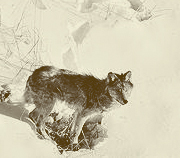The U.S. Fish and Wildlife Service announced this week that wolves in Minnesota and the western Great Lakes states will be removed from the endangered species list early next year.
The announcement appears to end a tortuous process of returning management of the animal to state jurisdiction. Court rulings had thwarted previous attempts to delist the animal which has enjoyed federal protection since 1974. The USFWS will publish a final delisting announcement in the Federal Register on December 28. After a 30-day period, management of the species will revert to the states.
More than 4,000 wolves populate in the USFWS’s three core recovery states in the western Great Lakes area and have exceeded the USFWS’s recovery goals. Minnesota’s population is estimated at 2,921 wolves, while an estimated 687 wolves live in Michigan’s Upper Peninsula and another 782 in Wisconsin. Each state has developed a plan to manage wolves after federal protection is removed.
“Gray wolves are thriving in the Great Lakes region, and their successful recovery is a testament to the hard work of the Service and our state and local partners,” U.S. Fish and Wildlife Service Director Dan Ashe said in a media release. “We are confident state and tribal wildlife managers in Michigan, Minnesota and Wisconsin will effectively manage healthy wolf populations now that federal protection is no longer needed.”
Wolves in Minnesota will be managed under a state wolf management plan adopted in 2001. Minnesota’s management plan establishes a minimum population of 1,600 wolves to ensure long-term wolf survival. Under state management, owners of domestic animals will have more authority to control wolves themselves and the state will also offer the services of certified private predator controllers. Hunting and trapping of wolves could become a reality as well.
“Today’s announcement by the federal government reaffirms the fact that the wolf is not threatened or endangered in Minnesota,” Minnesota Department of Natural Resources Commissioner Tom Landwehr said in a media release. “Minnesota’s wolf population has been above federal recovery goals for our state since 1989. Our management plan will ensure the long-term survival of this species.”
Read the USFWS media release HERE. Find additional USFWS wolf delisting information HERE.
Read the Minnesota DNR media release HERE. Detailed information on the Minnesota wolf management plan is HERE.


